The Lone Peak is Altra's best-seller and one of the most popular trail running shoes for hikers. Many hikers absolutely swear by Altra's "zero drop" and wide toe boxes, especially thru-hikers. It's also a popular recommendation on Facebook. At the same time, Altra's unusual fit doesn't work for all men and women. And several of my customers are absolutely convinced that their lower body injuries were the result of wearing Altras. That's why I consider the Altra Lone Peak a high risk, high reward trail shoe. This Altra Lone Peak review for hikers should help you figure out if this best-selling trail running shoe is a smart choice—or a risky choice—for your body and your hiking style.
Altra's Philosophy
Before getting into the nitty-gritty of my Altra Lone Peak review, it's worth calling out the brand's unique philosophy. For better or worse, Altra believes that the extra cushioning and support of traditional running (and hiking) shoes actually weaken people's lower bodies and reward people with poor running form. In contrast, Altras try to re-train people's lower bodies to function naturally with (1) balanced cushioning (formerly known as "zero drop"), (2) gender-specific fits, and (3) a Footshape fit with wide toe boxes.
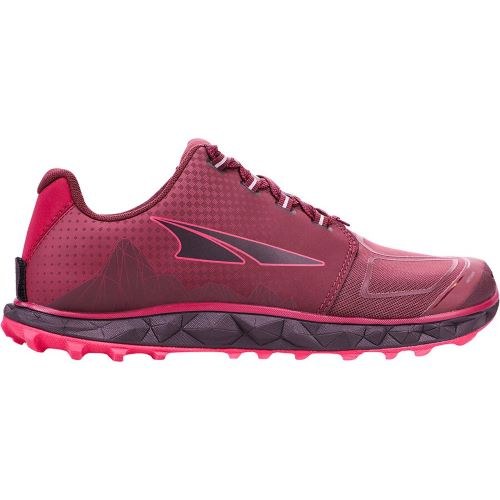
Balanced cushioning levels out the heel and toes
Balanced Cushioning
Altra's cult-like following largely stems from its "zero drop" design—now called "balanced cushioning." Both are fancy marketing term for a flat shoe. Most running shoes and hiking shoes place extra cushioning under the heel to soften your landing, support your feet, and take pressure off your lower back. In contrast, Altra removed that heel cushioning to position the heel, forefoot, and toes an equal distance off the ground (with zero drop from the heel down to the toe). That balanced cushioning supposedly helps people to land squarely on the mid-foot by making it uncomfortable to land on your heels, the edges of your feet, etc..
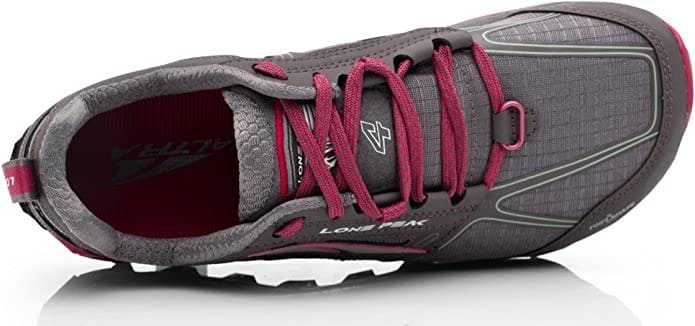
Women's Lone Peak with Fit4Her fit
Gender-Specific Fits
Altra also offers gender-specific fits—with their women's styles featuring Fit4Her lasts with a narrower heel and midfoot, higher instep, and longer arch than their men's lasts.
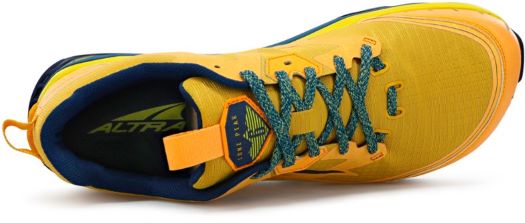
Footshape fit with wide toe box for natural toe splay
Footshape Fits
Altra argues that 98% of shoes have tapered toe boxes that are not shaped like the human foot. In contrast, Altra's Footshape fit features a wide toe box, so your toes splay out naturally for a solid base. Properly fitted, Lone Peaks should feel loose around your feet, almost like an oversized slipper, with a thumb's width of space between the tip of your toes and the end of the shoe. What might initially feel "too big" or "too wide" is actually the right fit—one that will make your feet and toes healthier over time.
Most Altras are not "mimimalist" or "barefoot" shoes. However, they're designed to make people rely upon their lower bodies for cushioning, stabilty, and support—not their shoes. That's the opposite of traditional running shoes and hiking shoes.
It's important to understand Altra's unique philosophy before buying the best-selling Lone Peak. If you're not a fan of traditional hiking shoes and prefer less supportive trail shoes to build up your lower body, the Altra Lone Peak might be a good choice for you. If you're looking for supportive trail shoes that take some heat off your feet and ankles, Altra is the wrong brand for you. As one of my fellow Backcountry Gearheads put it, "It shouldn't take you too long to figure out if you love Altras or absolutely hate them. There's not much middle ground."
I agree. That's why I wrote this Altra Lone Peak review— so you can figure out if you should join the swelling ranks of Altra fanatics or pass on the Lone Peak for a trail shoe that better fits your feet, body type, and hiking style.

ALBERT, BACKCOUNTRY GEARHEAD (and altra fan)
"It shouldn't take you too long to figure out if you'll love Altras or absolutely hate them.
There's not much middle ground."
Altra Lone Peak Review
My Altra Lone Peak Review evalates the support, weight, fit, comfort, traction, weather protection, durability, and value of Altra's best-selling trail running shoe. My review started with a gradual break-in period —to let my lower body adjust to zero drop/ balanced cushion— followed by several day hikes in Pennsylvania. For the most part, these test hikes were on easier trails than I normally hike. My plan was to progress to harder hikes that would test the shoes more. However, I stopped the review after 60 miles due to durability issues and injury concerns. This review of the Altra Lone Peak was based on the Lone Peak 4.5. However, most of these observations should hold true for the newer Lone Peak 6 and Lone Peak 7.
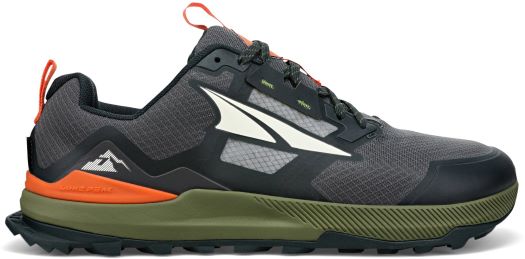
Support
LIMITED
By design, Lone Peaks don't have much support underfoot. It provides a thin plastic stone guard that may or may not prevent bruises from stepping on sharp rocks. Unlike the shanks or chassis of other trail shoes, that stoneguard offers minimal support and torsional rigidity (resistance to side to side twisting). That's Altra's MO—forcing your feet and ankles (not your shoes) to provide most of your stability and support.
No doubt, that limited support can be a springboard for some hikers to develop their lower bodies and show off their ripped calves. But not me. That light-duty build took its toll on mt (flat) feet, (genetically) weak ankles, and skinny calves. On easier trails tha I normally hike, I had trouble with rolled ankles, cramping feet, shin splints, and calf strains.
Again, the main point of buying Altras is to free yourself from the cushioning and support of traditional running shoes. For a little more cushioning and support, you might consider the new Olympus 5 Hike—which has worked out for me—or switch to a brand with more traditional support.
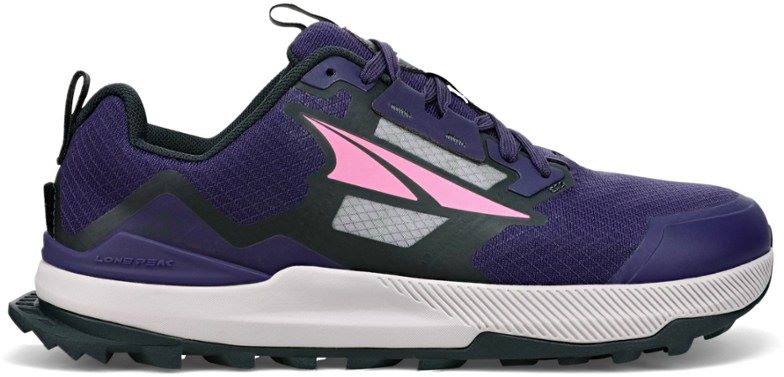
Weight
LIGHTWEIGHT (BY HIKING STANDARDS)
Many hikers buy Lone Peaks for their light weight. With thin uppers, limited support, and moderate cushioning, they weigh about a half-pound less than my recommendations for the best hiking shoes. They're a little heavier than many trail runners, but that's often a plus for hikers.
The average hiker doesn't hike fast enough or far enough for this weight savings to translate into energy savings. However, Lone Peaks may offer some energy savings for fast hikers and long distance hikers as the miles add up. Not surprisingly, the Lone Peak is most popular with thru-hikers.
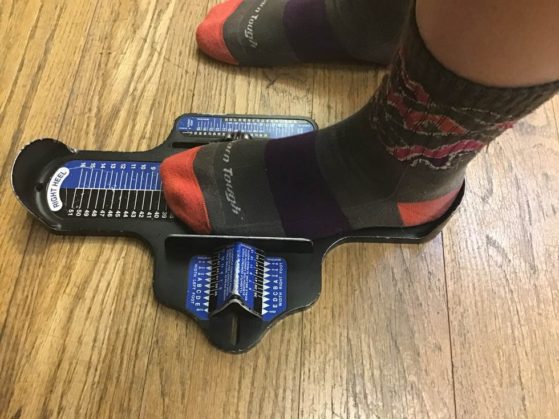
Fit
ROOMY WITH WIDE TOE BOX
The Altra Lone Peak runs true to size length-wise with a roomier fit in the forefoot and toes than other brands. Altra does not consider this a wide fit —its a natural, Footshape fit — but it's wider in the forefoot and toes than other brands (which might appeal to hikers with wide feet). I got the best fit by sizing up a half-size from my everyday shoe size and did not need a wide (like I do in many brands). The Altra fit mostly worked for me, especially that yummy toe box. Still, my feet slid around on rocky trails and slid forward on steep ones, which can lead to toe and foot iossues. (I get a more secure fit in Topo Athletic—a brand with some similarities to Altra.) If you try on the Altra Lone Peak, keep in mind the fitting advice from Altra co-founder Golden Harper: “If they don’t feel too big in your toes, they’re too small!”

Comfort
Comfort is a subjective thing that has a lot to do with fit, body type, and the specific types of hiking you do. The Lone Peak's roomy toe box, moderate cushioning, and minimal support works for many hikers. When it works for you, the Lone Peak can feel like your favorite slipper with trail traction. For others, though, that big toe box may be uncomfortable or feel sloppy on technial terrain. Personally, I found the Lone Peak pretty comfortable on easier trails but not on steeper, tougher trails. That being said, plenty of people absolutely love that comparatively loose fit and max toe room.
I'm all about those roomy toe boxes, but not all about the zero drop. (For what it's worth, the podiatrist who trained me in hiking footwear had the same take on Altra trail running shoes.) Sadly, I quit hiking in my Lone Peaks after my second calf strain in fifty miles—after zero calf strains in my previous 10,000 miles in other brands (and none in 3000 Altra-free miles since). Some of my customers, co-workers, and friends have had more serious issues in the Altra Lone Peak, including injuries such as stress fractures, broken ankles, and ruptures Achilles tendons.
Hikers with ripped calves and more athletic bodies may find the Altra Lone Peak super comfortable. HIkers (like me) with skinny calves and flat feet may be more susceptible to zero drop injuries. Also consider that some professionals believe that zero drop shoes make no difference in injury rates, only work for strong athletes with good form, and correlate with increased lower leg and foot injuries.
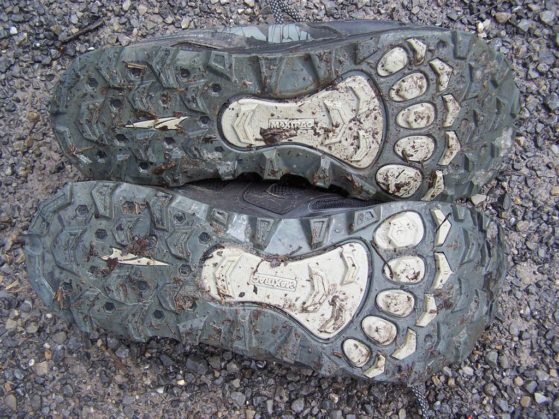
Traction
AVERAGE
Overall, the shoe has multipurpose traction that works for a range of trails.
The Lone Peak has grippy outsoles made of soft rubber with some widely spaced lugs. The shoe's chevron-shaped lugs ("trail claw" pattern) can dig into loose surfaces, such as mud and scree, on steeper uphills and downhills. That soft rubber feels fairly grippy on flat rock, too, as long as it's not wet. Overall, that's pretty solid tread for average hikers.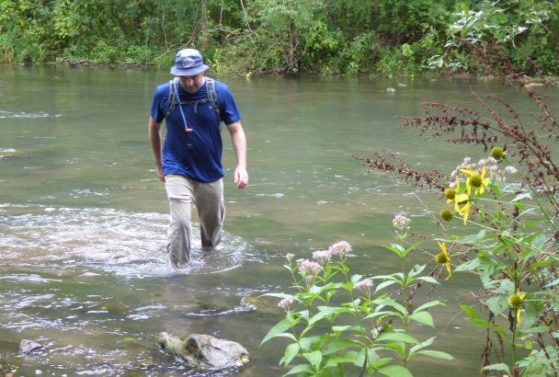
water crossing in the non-waterproof Altra Lone Peak
Weather Protection
AVAILABLE IN ALL-WEATHER
Like most Altra fans, I chose the non-waterproof Altra Lone Peak. (For a waterproof version, try the Lone Peak All Weather.) Most people who choose to hike in trail runners will pair non-waterproof shoes with Merino blend hiking socks for a fast-drying system. The thought is that your feet will probably get wet in trail running shoes—either from sweat or rain or water crossings—so you might as well pick a shoe that dries quickly. Altra designed Lone Peaks to drain water (which also means they also let water in easily, too.) Their air mesh also will dry out pretty quickly if Lone Peaks get swamped by sweat or creek crossings.
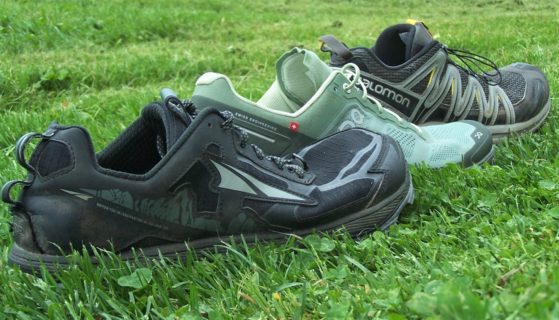
Durability
BELOW AVERAGE
One of the big knocks against Altra is durability. Trail runners don't last long anyway, and the Lone Peak may wear out faster than many trail runners.
Most trail running shoes are made to be replaced after approximately 250-300 miles—half as long as the average hiking boot. Many outdoor industry pros plan on getting 200 miles or less out of Lone Peaks. (You may get more or less mileage based on your weight, gait, the terrain you hike, etc.) I retired my pair around 60 miles of easy to moderate trails because they seemed to be packing out and were delaminating at the toe cap. My local outdoor gear shop then rejected them for their used gear section because they were "too worn out"...at only 60 miles. Weigh that experience against the thru-hikers who claim to get 400-500 miles out of their Lone Peaks.
water crossing in the non-waterproof Altra Lone Peak
Price
AVERAGE
In 2023, hikers can score close-out prices on the older Lone Peak 6 or pick up the newer Lone Peak 7, which now starts at $150 (MSRP) in non-waterproof. Compared to the best trail running shoes, that slots in $10 less than La Sportiva's Ultra Raptor, $5 less than the Hoka Speedgoat, the same price as the Topo Ultraventure Pro, $10 more than the Brooks Cascadia, and $20 more than the Salomon XA Pro. With trail running shoes' prices spiking, that puts the Altra Lone Peak around average in terms of value —with potentially exceptional features, such as its zero drop design and wide toe boxes.


This post including affiliate links, including the links above. If you buy something after clicking on a link, the retailer may share a small percentage of the sale with Hiking Feet. That's free for you—and lets you support this site's free and independent content.
Altra Lone Peak: Pros vs Cons
My Altra Lone Peak is pretty mixed. It's a great trail shoe for many hikers. And the wrong trail shoe for many hikers. Here are the Altra Lone Peak's pros and cons:
Overall Recommendation:
The Altra Lone Peak was the most popular—and least popular—shoe that Appalachian Outdoors carried when I managed footwear. There's not much middle ground with the Altra Lone Peak. You'll either love it or hate it. My Altra Lone Peak review should help you figure out if this uber-popular trail running shoe makes sense for your body and hiking style—or not.
If the Altra Lone Peak suits your body and your hikes, you may fall in love with this comfortable, lightweight, fast-drying trail shoe with the roomy toe box and balanced cushioning that restores your lower body's natural biomechanics. If it doesn't suit your body or your hikes, however, you may hate this unsupportive trail shoe with the sloppy fit that puts unnecessary stress on your feet, ankles, and calves before it falls apart.
HIke your own hike. But that's my blunt take on the Altra Lone Peak.
Should you buy the Altra Lone Peak?
At this point, my Altra Lone Peak review should have given you a pretty good idea if the Altra Lone Peak is the right kind of trail running shoe for your hikes—or not. Personally, I've had better luck with the Altra Olympus 5 Hike and prefer Topo Athletic to Altra. But your body is different from mine (if you're lucky!). So is your hiking style. And, of course, there are millions of runners and hikers who wouldn't think of hiking in another shoe or another brand.
If you want to join the legions of Altra lovers, please consider purchasing your pair through the affiliate links above. That's free for you and may send a few dollars my way. That covers my costs, pays for the boots and shoes I review, and gives me a little back for the thousands of unpaid hours I've spent writing free and independent content to help people I don't know buy the hiking boots, hiking shoes, and trail running shoes that make the most sense for them.
If this post helped you, please consider helping me, too. Thanks, and happy hiking!
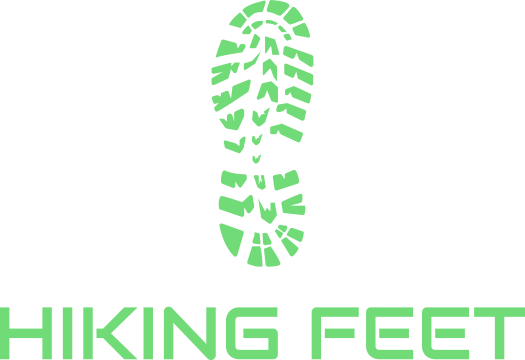
Comments are closed.